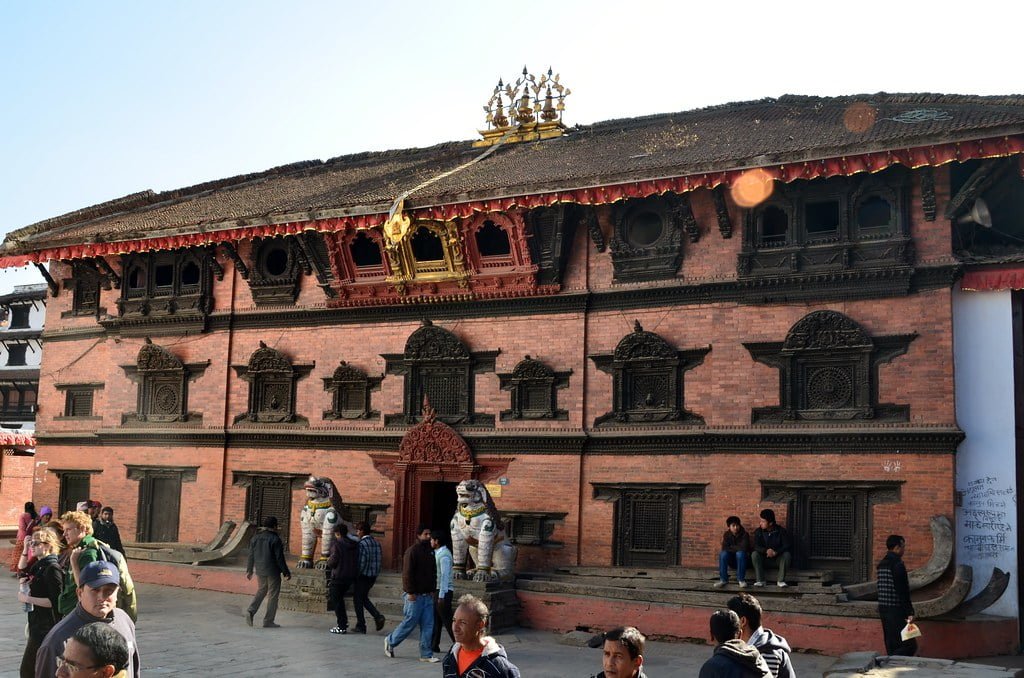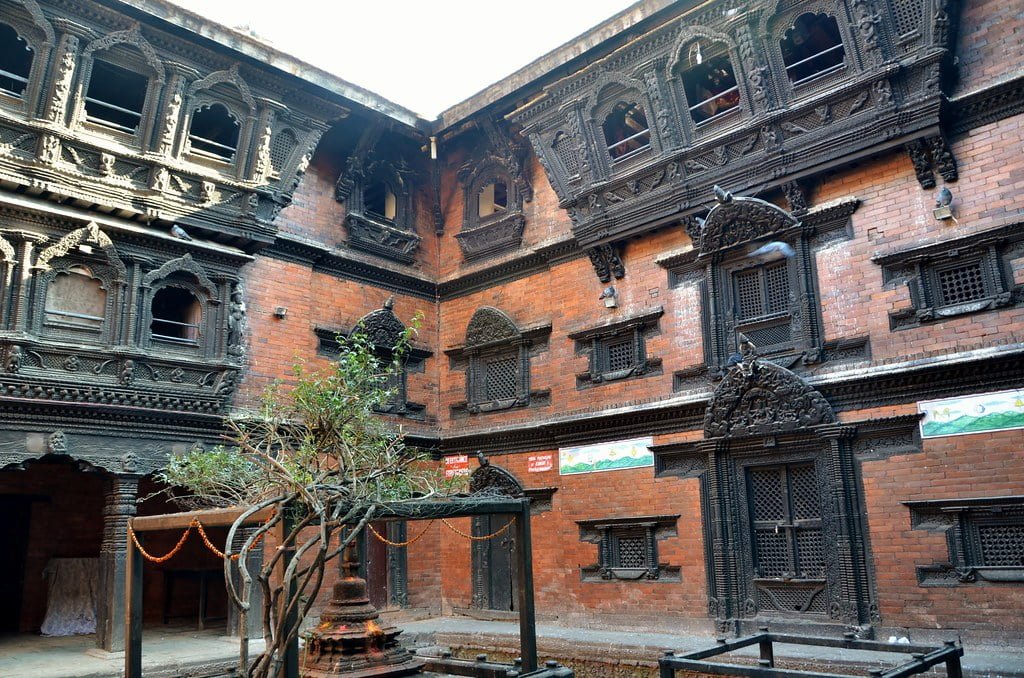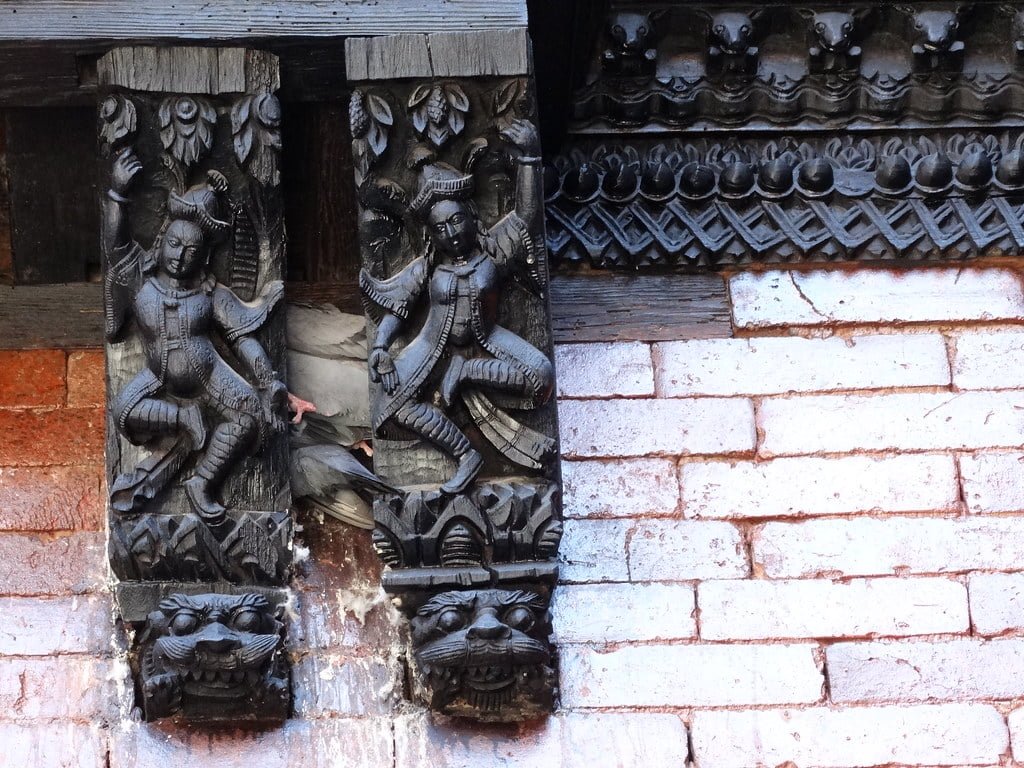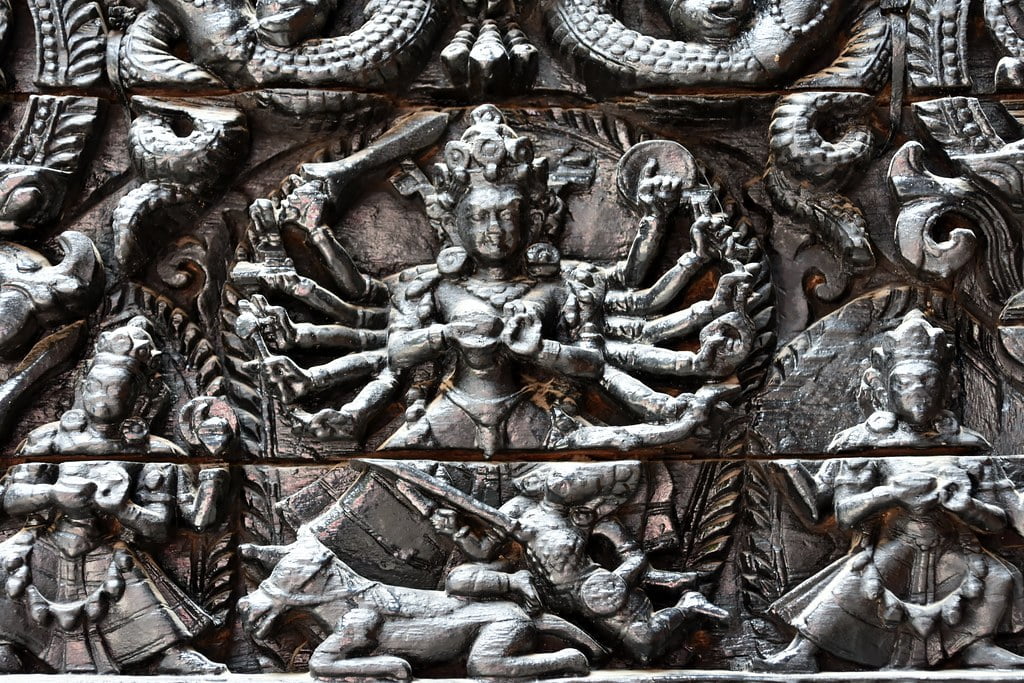Kumari Bahal: The Sacred Abode of the Living Goddess
Nestled within the enchanting Kathmandu Durbar Square in Basantapur, the Kumari Bahal, also known as the Kumari Ghar, stands as a magnificent testament to architectural brilliance and serves as the sacred dwelling of the living goddess or vestal virgin. This three-story traditional structure, built in the mid-1700s by King Jaya Prakash Malla, not only captivates visitors with its exquisite design but also offers a unique insight into the religious and cultural traditions of Nepal.
The Kumari Bahal is a beautiful ancient palace, made of wood and red bricks, adorned with intricately carved windows, doors, and balconies that resemble a Buddhist Vihara. Its lavish decoration and fine woodcarvings highlight the craftsmanship of the artisans of that era, making it a sight to behold. As one approaches the Kumari Bahal, the grandeur and reverence surrounding it are palpable, making it a must-visit destination for both locals and tourists.
This sacred abode is not only an architectural marvel but also holds great religious significance. The Kumari, believed to be the bodily incarnation of the goddess Taleju, resides within the Kumari Bahal until she menstruates. According to the tradition, once the Kumari reaches puberty, it is believed that the goddess vacates her body, and a new Kumari is selected through a rigorous process. This process involves various rituals and tests to identify a young girl who possesses the divine qualities required to become the living goddess.
Inside the Kumari Bahal, visitors can witness the divine atmosphere pervading the surroundings. The palace houses a stupa adorned with symbols of Goddess Saraswati, representing knowledge and learning. Additionally, a huge chariot is kept within the premises, which is used to take the Kumari around the city during special occasions and festivals, allowing devotees to seek her divine blessings.
The Kumari Bahal holds a pivotal role in the religious and cultural fabric of Nepal. People from all walks of life make a beeline to catch a glimpse of the Kumari and receive her blessings. It serves as a spiritual sanctuary, evoking a sense of awe and wonder among all those who enter its hallowed grounds.
Visiting the Kumari Bahal is not only an opportunity to witness the architectural splendor of Nepal but also a chance to immerse oneself in the rich cultural heritage and religious traditions of the country. It offers a deep insight into the devotion and reverence bestowed upon the Kumari, and the significance she holds as a living goddess in the hearts and minds of the Nepalese people.
History of Kumari Bahal
The Kumari Bahal, also known as the House of Living Goddess Kumari, holds great historical and cultural significance in Nepal. Built in the year 1757 by King Jaya Prakash Malla, the Kumari Bahal was named after the Kumari goddess, who is believed to be the bodily incarnation of the goddess Taleju (known as Durga in the Nepalese culture).
The Kumari Bahal is a three-storied quadrangle that boasts exquisite woodcarvings, making it a visually stunning structure. Unlike traditional temples, the design of the Kumari Bahal resembles that of a house, with a central courtyard called Kumari Chowk, known as the ‘Courtyard of the Kumari’.
The primary purpose of the Kumari Bahal is to serve as the residence for the Kumari Devi, the Living Goddess. The Kumari Devi is a young girl who is carefully selected through a rigorous process. She is believed to be the living incarnation of the goddess Taleju until she menstruates or experiences a serious illness or major loss of blood, which is believed to cause the goddess to vacate her body.
The selection process for the Kumari Devi is known for its strict rules and meticulous evaluation. The chosen Kumari Devi is then brought to the Kumari Bahal, where she resides until her divine reign comes to an end. The Kumari Bahal becomes a sacred space, where people from far and wide come to seek the blessings of the Living Goddess.
Throughout the years, the Kumari Bahal has witnessed various historical events and has remained a symbol of religious and cultural pride for the people of Nepal. The building’s architectural beauty, particularly its intricately carved wooden windows, is a testament to the craftsmanship of the artisans of that era.
Today, the Kumari Bahal continues to be a popular attraction, drawing visitors who are eager to catch a glimpse of the Kumari Devi and receive her divine blessings. It stands as a living testament to the rich cultural heritage of Nepal and the importance of the divine female energy in South Asian countries.

The Architecture of Kumari Bahal
The Design and Layout of the Temple
The Kumari Ghar in Durbar Square is a magnificent structure that showcases exquisite design and craftsmanship. Built in 1757 by Jaya Prakash Malla, the building follows the style of the Buddhist vihara, or monastic abodes, of the valley. Its architectural beauty is evident from the moment visitors approach the temple.
The entrance of the Kumari Ghar is a grand three-step entrance guarded by two majestic white-painted stone lions. This impressive gateway sets the tone for what lies beyond. As visitors enter the temple’s courtyard, they are greeted by a remarkable wooden Toran, a prime example of exceptional temple artistry. Its intricate carvings and attention to detail are a testament to the skill of the craftsmen.
Moving further into the temple, the first floor features four beautifully carved windows. Each window is a work of art, showcasing the mastery of temple architecture. The second floor boasts seven windows, with the four large outer windows adorned with famous peacock designs. These intricate designs add a touch of elegance to the temple, further enhancing its visual appeal.
Continuing upwards to the third floor, the windows take on a more conventional appearance. The center of the third floor is adorned with black-painted triple groupings, while round windows in rectangular frames are placed between them. These windows, although less elaborate than the ones below, still contribute to the overall aesthetic of the temple.

Delicately carved cornices adorn the walls just below the ceiling, adding a final touch of beauty to the temple’s interior. These ornamental moldings serve as a testament to the attention to detail and craftsmanship that went into creating the Kumari Ghar.
The design and layout of the Kumari Ghar is not only visually stunning but also holds deep religious significance. The temple is considered the sacred home of the living goddess, or vestal virgin, and has housed goddess-children since its construction. The presence of the goddess is revered, and visitors have the opportunity to catch a glimpse of her face between 9 am and 11 am. However, it is important to note that photographing the goddess is forbidden.
Despite the destruction caused by the 2015 earthquake, the Kumari Ghar miraculously escaped with only minor damage. Many see this as a sign of the Kumari’s benign influence, further cementing the temple’s importance and significance.
The Cultural and Religious Significance
The Goddesses and Divinity Associated with Kumari Bahal
Kumari Bahal, also known as the House of the Living Goddess Kumari, holds immense significance in Nepalese culture and religious beliefs. The building, constructed in the 18th century by King Jaya Prakash Malla, is not just an architectural marvel but also a sacred abode that is believed to house divine energies and goddesses.
At the heart of Kumari Bahal lies the Kumari Chowk, the Courtyard of the Kumari. It is in this central courtyard that the living goddess, known as Kumari, resides. The selection process for the Kumari is rigorous and deeply rooted in tradition. It is believed that the Kumari is the bodily incarnation of the goddess Taleju, who is revered in Nepalese mythology as a form of Durga.
The Kumari is chosen from a young girl who must meet specific criteria, including being from the Shakya or Bajracharya caste, possessing flawless physical attributes, and passing various tests. Once selected, she must undergo a series of rituals and be isolated in Kumari Ghar until she menstruates or experiences a major loss of blood, at which point it is believed that the goddess vacates her body. This transition from goddess to ordinary mortal is a significant moment in the Kumari’s life.
The Kumari Bahal itself is a testament to the belief in the divine presence within its walls. Designed more like a house than a temple, the building features exquisite woodcarvings and three stories of architectural beauty. The most notable feature of the Kumari Bahal is its wooden windows, which showcase the expert craftsmanship of the time.
Devotees and visitors from all walks of life flock to Kumari Bahal, hoping to catch a glimpse of the living goddess and seek her divine blessings. The Kumari, adorned in traditional attire and intricate jewelry, sits on a throne within the courtyard, symbolizing the merging of the mortal and the divine. Her presence is believed to bring good fortune, prosperity, and protection to those who come seeking her blessings.
The association of goddesses and divinity with Kumari Bahal goes beyond the physical presence of the living goddess. It is a place where the spiritual and the mortal realms intersect, where devotees can connect with the divine and experience a sense of awe and reverence. The Kumari Bahal stands as a testament to the deep-rooted religious beliefs and cultural practices that have shaped Nepal for centuries.

The Role and Duties of the Kumari
The Kumari, revered as the Living Goddess of Nepal, holds a significant role in the spiritual and cultural fabric of the country. Chosen from the Shakya caste or Bajracharya clan of the Nepalese Newari Buddhist community, the Kumari is believed to be the earthly manifestation of the divine feminine energy, specifically the goddess Taleju. From the moment of selection until she reaches puberty, the Kumari is venerated and worshipped by both Hindus and Buddhists alike.
The primary duty of the Kumari is to bestow blessings upon the devotees who come to seek her audience. She resides in a sacred palace known as the Kumari Ghar, where she is visited by people from all walks of life seeking guidance, protection, and the fulfillment of their wishes. The Kumari represents the divine consciousness spread throughout creation, and her presence is believed to bring good fortune and spiritual enlightenment.
During her tenure as a living goddess, the Kumari is treated with utmost care and reverence. Her needs and desires are attended to by a group of individuals known as the Kumarimi, led by a patron. The Kumarimi are responsible for the Kumari’s daily care, which includes bathing, dressing, and attending to her makeup. They also provide instruction in her ceremonial duties, as she is expected to perform various rituals and participate in religious festivals throughout the year.
One of the most important roles of the Kumari is her participation in the annual festival of Indra Jatra. During this festival, the Kumari is taken around the city in a grand chariot, symbolizing her divine presence and invoking blessings upon the people. This procession is a significant event for the local community and attracts a large number of devotees and tourists.
The Kumari’s presence is believed to bring good fortune, but it is also believed that her departure, which occurs when she reaches puberty, causes the goddess Taleju to vacate her body. This event is marked by her first menstruation or by serious illness or injury resulting in a major loss of blood. Once the Kumari returns to mortal life, another young girl is carefully selected through a rigorous process to take her place as the new Living Goddess.
The Controversy Surrounding the Kumari Tradition
The tradition of the Kumari, or living goddess, in Nepal has been a subject of controversy and debate in recent years. While the practice of worshiping young pre-pubescent girls as manifestations of the divine female energy dates back thousands of years in South Asian countries, concerns have been raised about the ethical implications and impact on the lives of these young girls.
One of the main controversies surrounding the Kumari tradition is the selection process. In Nepal, the selection of the Kumari is a rigorous and often lengthy process. It involves various rituals, screenings, and tests to determine the suitability of a young girl for the role. However, there are claims that the selection process may not be as transparent or fair as it is believed to be.
Some critics argue that the selection process is arbitrary and lacks transparency. They question the involvement of the government and influential individuals in the final selection, which may undermine the authenticity and integrity of the process. Additionally, concerns have been raised about the pressure placed on young girls and their families to conform to societal expectations and traditions.
Another controversy surrounding the Kumari tradition is the impact it has on the lives of these young girls. Being chosen as a Kumari comes with significant sacrifices and restrictions. The Kumari is required to live a secluded life, confined to the Kumari Ghar (House of Living Goddess) and only allowed to leave for certain religious ceremonies. She is not allowed to attend school, have friends her own age, or participate in normal childhood activities.
Critics argue that this isolation and lack of normalcy can have detrimental effects on the mental and emotional well-being of the Kumari. They believe that it deprives these young girls of a normal childhood and may lead to social and psychological challenges later in life. The pressure to adhere to the expectations of being a divine figure may also create immense stress and burden for the Kumari.
Furthermore, the practice of worshiping young girls as goddesses perpetuates gender inequality and reinforces patriarchal norms. By elevating young girls to the status of a divine being, it reinforces the belief that women are only valued for their purity and beauty. This can have long-lasting implications on the perception and treatment of women in society.

